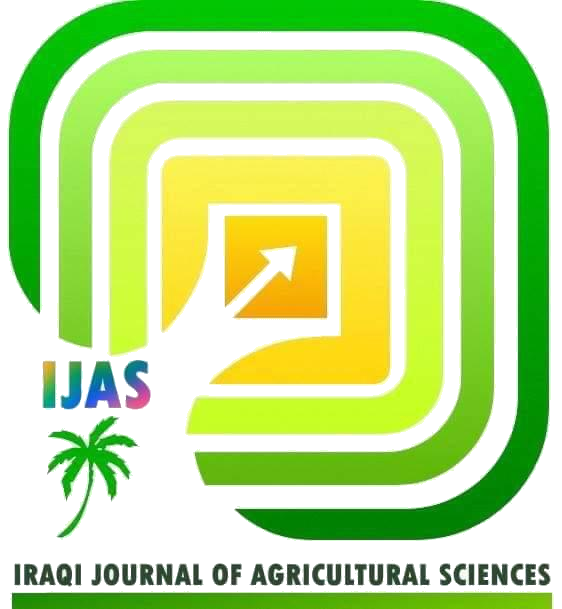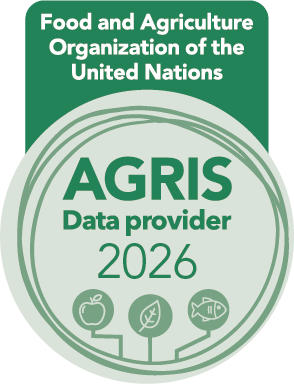EXTENDING THE MARKETABILITY OF TOMATO FRUITS AND ENHANCING THEIR QUALITY THROUGH GENE SILENCING AND ORGANIC CALCIUM-PECTIN APPLICATION
DOI:
https://doi.org/10.36103/3mthpm17Keywords:
RNAi, fruit weight loss, fruit firmness, responsible consumption, vitamin C, total acidity percentage, carotene, lycopene.Abstract
This study aimed to investigate the impact of nine treatments on tomato plants and their planting location within a randomized complete block design. The treatments included gene silencing of the PL enzyme (RNAi-SlPL) and application of organic pectin and calcium to extend the marketability of tomato fruits and improve their quality. The RNAi-SlPL treatment outperformed others, revealed the lowest weight loss (41.4%) and highest firmness (4.89 kg·cm⁻²) after 36 days of cold storage, along with strong performance after 21 days at room storage (41.31% weight loss, 4.29 kg·cm⁻²). This was followed by CaP1P2 treatment, with 43.7% weight loss and 4.48 kg·cm⁻² firmness after 24 days of cold storage, and 45.87% weight loss with 4.15 kg·cm⁻² firmness after 14 days at room storage. Both treatments significantly boosted carotenoid (2.640 and 2.728 mg/100ml respectively) and lycopene (4.62 and 4.81 mg/100ml) levels post- cold storage. These findings highlight the effectiveness of RNAi technology and the use of organic pectin and calcium in extending the marketability of tomato fruits.
References
1. Al-Khafaji, A. M. H. H. and K. D. H. Al-jubouri, 2024. Developmental control of some physiological factors on reproductive biology and rudimentary embryos phenomenon in carrot seeds. Iraqi Journal of Agricultural Sci. 55(3): 1038-1047. https://doi.org/10.36103/zvrre033
2. Bargel, H., and C. Neinhuis. 2005. Tomato (Lycopersicon esculentum Mill.) Fruit Growth and Ripening as Related to The Biomechanical Properties of Fruit Skin and Isolated Cuticle. Journal of Experimental Botany 56(413): 1049–1060.
doi: https://doi.org/10.1093/jxb/eri098.
3. Bramley, P. M. 2002. Regulation of Carotenoid Formation During Tomato Fruit Ripening and Development. Journal of Experimental Botany 53(377): 2107–2113. doi: https://doi.org/10.1093/jxb/erf059.
4. Buke, T., and A. Semira. 2024. Peer Review History: Effect of Calcium Chloride Treatment on Phostharvest Quality of Tomato (Lycopersicon esculentum Mill), Ethiopia - open peer review.globalpresshub.com https://prh.globalpresshub.com/review-history/1518
5. Castro, J.C., C.G. Castro, and M. Cobos. 2023. Genetic and Biochemical Strategies for Regulation Of L-Ascorbic Acid Biosynthesis in Plants Through The L-Galactose Pathway. Frontiers in Plant Science 14. doi: https://doi.org/10.3389/fpls.2023.1099829.
6. Coulibaly, A.S., K.L. Kouakou, J.P. Dao, C. Kouakou, J. K. Dedi, et al. 2023. Enhancing tomato (Solanum Lycopersicum l.) fruit yield and quality and blossom end rot control using different biological calcium sources. Journal of Agricultural Chemistry and Environment 12(3): 263–274.
doi: https://doi.org/10.4236/jacen.2023.123020
7. Ding, X., X. Liu, G. Jiang, Z. Li, Y. Song, et al. 2022. Sljmj orchestrates tomato fruit ripening via crosstalk between h3k4me3 and DML2‐Mediated DNA Demethylation. New Phytologist 233(3):1202–1219.
doi: https://doi.org/10.1111/nph.17838.
8. Do, J.H., S.Y. Park, S.H. Park, H.M. Kim, S.H. Ma, et al. 2022. Development of a genome-edited tomato with high ascorbate content during later stage of fruit ripening through mutation of SlAPX4. Frontiers in Plant Science 13.
doi: https://doi.org/10.3389/fpls.2022.836916.
9. Dodgson, J., A.K. Weston, and D.J. Marks. 2023. Tomato firmness and shelf-life increased by application of stimulated calcium. Crops 3(4): 251–265.
doi: https://doi.org/10.3390/crops3040023.
10. Duret, S., C. Aubert, S. Annibal, E. Derens-Bertheau, V. Cottet, et al.2025. Impact of harvest maturity and storage conditions on tomato quality: a comprehensive experimental and modeling study. postharvest biology and Technology 219: 113286–113286. doi:https://doi.org/10.1016/j.postharvbio.2024.113286.
11. Ecker, J. R. 2013. Epigenetic trigger for tomato ripening. Nature Biotechnology 31(2): 119–120.
doi: https://doi.org/10.1038/nbt.2497.
12. Elias, M.S., and K.D.H. Al-Jubouri. 2022. investigate genetic relation among watermelon cultivars using molecular dna markers. iraqi journal of agricultural sci. 53(3): 712–723. doi: https://doi.org/10.36103/ijas.v53i3.1581.
13. Flores, K.S.U., G. Silva, N. Barboza, S. Garcia, D. Cavenaghi, et al. 2023. Pectin-Based Edible Coating Containing Gibberellic Acid in The Post-Harvest Conservation of Fresh Tomatoes. Ciência Agrotecnologia47.doi:https://doi.org/10.1590/1413-7054202347009223.
14. Forand, A.D., Y.Z. Finfrock, M. Lavier, J. Stobbs, L. Qin, et al. 2022.With a little help from my cell wall: structural modifications in pectin may play a role to overcome both dehydration Stress and Fungal Pathogens. Plants 11(3): 385.
doi: https://doi.org/10.3390/plants11030385.
15. Gummadi, S. N., and T. Panda. 2003. analysis of kinetic data of pectinases with substrate inhibition. Journal of Microbiology and Biotechnology 13(3): 332–337.
16. Haider, S.T.A., M.A. Anjum, M.N. Shah, A. U. Hassan, M. Parveen, etal. 2024. Deciphering the effects of different calcium sources on the plant growth, yield, quality, and postharvest Quality Parameters of “Tomato.” Horticulturae 10(9): 1003–1003. doi: https://doi.org/10.3390/horticulturae10091003.
17. Hernández, V., P. Hellín, J. Fenoll, M.V. Molina, I. Garrido, et al. 2018. Impact of high temperature stress on ascorbic acid concentration In Tomato. Acta Horticulturae (1194): 985–990. doi: https://doi.org/10.17660/actahortic.2018.1194.140.
18. Jayarathna, G.E., S.B. Navaratne, and I. Wickramasinghe. 2023. development of lycopene content in tomatoes at colour break and variation of it during storage and processing Carpathian Journal of Food Science And Technology 15(3): 116–125. doi: https://doi.org/10.34302/crpjfst/2023.15.3.9.
19. Jhanani, G.K., M.S. Al Salhi, N. T. and R. Shanmuganathan. 2024. As assessment of shelf-life increasing competence of pectin (Zucchini) based edible coating on tomatoes. Environmental Research 258: 119368. doi: https://doi.org/10.1016/j.envres.2024.119368. doi: https://doi.org/10.1104/pp.20.01203
20. Kalamaki, M.S., N.G. Stoforos, and P. Taoukis. 2006. Pectic Enzymes in Tomatoes.: 271–290. doi: https://doi.org/10.1002/9780470277577.ch12.
21. Kathimba, F.K., P.M. Kimani, R.D. Narla, and L. M. Kiirika. 2022. Effect of storage temperature on fruit firmness and weight loss of nine tomato lines. African J. of Plant Science 16(10), pp. 276-284.
22. Kavanagh, F. 1981. Official methods of analysis of the AOAC, 13th ed. Edited by WILLIAM HORWITZ. The Association of Official Analytical Chemists. Journal of Pharmaceutical Sciences 70(4): 468. doi: https://doi.org/10.1002/jps.2600700437.
23. Kim, J.-S., K. Ezura, J. Lee, T. Ariizumi, and H. Ezura. 2019. Genetic engineering of parthenocarpic tomato plants using transient SlIAA9 knockdown by novel tissue-specific promoters. Scientific Reports 9(1). doi: https://doi.org/10.1038/s41598- 019-55400-7.
24. Lata, H., A. Sharma, S. Chadha, M. Kaur, and P. Kumar. 2021. RNA interference (RNAi) mechanism and application in vegetable crops. The Journal of Horticultural Science and Biotechnology 97(2): 160–170. doi: https://doi.org/10.1080/14620316.2021.1988729.
25. Ming, Y., L. Jiang, and D. Ji. 2023. Epigenetic regulation in tomato fruit ripening. Frontiers in Plant Science 14. doi: https://doi.org/10.3389/fpls.2023.1269090 .
26. Mohammed, R.R., and B.H. Majeed. 2023. effect of moringa leaves extract, calcium, and potassium silicate on the growth, yield, and quality of strawberry fruits. iraqi journal of agricultural sci. 54(6): 1703–1715. doi: https://doi.org/10.36103/ijas.v54i6.1869.
27. Nagata, M., and I. Yamashita. 1992. Simple method for simultaneous determination of chlorophyll and carotenoids in tomato Fruit. Nippon Shokuhin Kogyo Gakkaishi 39(10): 925–928.
doi: https://doi.org/10.3136/nskkk1962.39.925
28. Obomighie, I., I.J. Prentice, P. Lewin-Jones, F. Bachtiger, N. Ramsay, et al. 2025. Understanding pectin cross-linking in plant cell walls. Communications Biology 8(1). doi: https://doi.org/10.1038/s42003-025-07495-0.
29. Ortega‐Salazar, I., D. Crum, A. Sbodio, Y. Sugiyama, A. Adaskaveg, et al. 2023. Double CRISPR knockout of pectin degrading enzymes improves tomato shelf-life while ensuring fruit quality.Plants, people, planet.doi: https://doi.org/10.1002/ppp3.10445.
30. Pare, J.M., and T.C. Hobman. 2007. Dicer: Structure, Function And Role In RNA-Dependent Gene-Silencing Pathways. Springer e Books: 421–438. doi: https://doi.org/10.1007/1-4020-5377-0_24.
31. Park, M.H., P. Sangwanangkul, and D.R. Baek. 2018. Changes in carotenoid and chlorophyll content of black tomatoes (Lycopersicon esculentum L.) during storage at various temperatures. Saudi Journal of Biological Sciences 25(1): 57–65. doi: https://doi.org/10.1016/j.sjbs.2016.10.002.
32. Patel, B., R. Sutar, S. Khanbarad, and V. Darji. 2016. Effect of different precooling techniques on the storage behavior of tomato fruits at low and ambient temperatures. Vegetable Science 43(2): 184–189.
33. Polwaththa, K.D.M., and Y.A. Amarasinghe. 2024. Corresponding author: Optimizing calcium application strategies to enhance fruit quality in tomato (Lycopersicon esculentum (L.) Mill). International Journal of Science and Research Archive 13(02): 596–602. doi: https://doi.org/10.30574/ijsra.2024.13.2.2188.
34. Poosarla, V.G., S. Bisoi, A. Siripurapu, B.G. Rathod, A. Ramadoss, et al. 2024. Extension of shelf life of tomato (Solanum lycopersicum L.) by using a coating of polyhydroxybutyrate‐carboxymethyl cellulose‐pectin‐thymol conjugate. Journal of Food Science. doi: https://doi.org/10.1111/1750-3841.17312
35. Santhosh, S.S., T. Chitdeshwari, and K. Chinnasamy. 2023. Calcium influences biochemical and antioxidant enzymatic activities in tomato fruits during storage. Journal of Applied Biology & Biotechnology. doi: https://doi.org/10.7324/jabb.2023.110216.
36. Saurabh, S., A.S. Vidyarthi, and D. Prasad. 2014. RNA interference: concept to reality in crop improvement. Planta 239(3): 543–564. doi: https://doi.org/10.1007/s00425-013-2019-5
37. Shah, I.H., W. Jinhui, X. Li, M.K. Hameed, M.A. Manzoor, et al. 2024. Exploring the role of nitrogen and potassium in photosynthesis implications for sugar: Accumulation and translocation in horticultural crops. Scientia Horticulturae 327: 112832. doi: https://doi.org/10.1016/j.scienta.2023.112832.
38. Shi, X., J. Bao, X. Lu, L. Ma, Y. Zhao, et al. 2023a. The mechanism of Ca+2 signal transduction in plants responding to abiotic stresses. Environmental and Experimental Botany 216:105514–105514. doi: https://doi.org/10.1016/j.envexpbot.2023.105514.
39. Shi, Y., B.J. Li, D. Grierson, and K.S. Chen. 2023b. Insights into cell wall changes during fruit softening from transgenic and naturally occurring mutants. Plant physiology 192(3): 1671–1683. doi: https://doi.org/10.1093/plphys/kiad128.
40. Thor, K. 2019. Calcium—Nutrient and Messenger. Frontiers in Plant Science 10.
doi: https://doi.org/10.3389/fpls.2019.00440
41. Uluisik, S., N.H. Chapman, R. Smith, M. Poole, G. Adams, et al. 2016. Genetic improvement of tomato by targeted control of fruit softening. - Sheffield Hallam University Research Archive. Shu.ac.uk. doi:https://shura.shu.ac.uk/31152/1/Gillis- GeneticImprovementTomato%28AM%29.pdf.
42. Wang, D., T.H. Yeats, S. Uluisik, J.K.C. Rose, and G.B. Seymour2018. Fruit Softening: Revisiting the Role of PectinTrends in Plant Science 23(4): 302–310. doi: https://doi.org/10.1016/j.tplants.2018.01.006
43. Wang, D., N.H. Samsulrizal, C. Yan, N.S. Allcock, J. Craigon, et al. 2019. Characterization of CRISPR mutants targeting genes modulating pectin degradation in ripening tomato. Plant Physiology 179(2): 544–557.
doi: https://doi.org/10.1104/pp.18.01187.
44. William, H. 1980. Official methods of analysis of the Association of Official Analytical Chemists. 13th ed.
45. Xu, Z., J. Dai, T. Kang, K. Shah, Q. Li, et al. 2022. PpePL1 and PpePL15 Are the Core Members of the Pectate Lyase Gene Family Involved in Peach Fruit Ripening and Softening. Frontiers in Plant Science 13. Doi : https://doi.org/10.3389/fpls.2022.844055.
46. Yang, L., W. Huang, F. Xiong, Z. Xian, D. Su, et al. 2017. Silencing ofSlPL, which encodes a pectate lyase in tomato, confers enhanced fruit firmness, prolonged shelf-life and reduced susceptibility to grey mould. Plant Biotechnology Journal 15(12): 1544–1555. doi: https://doi.org/10.1111/pbi.12737.
47. Yang, X., X. Zhang, Y. Yang, H. Zhang, W. Zhu, et al. 2021. The histone variant SlH2A.Z regulates carotenoid biosynthesis and gene expression during tomato fruit ripening. Horticulture Research 8(1). doi: https://doi.org/10.1038/s41438-021-00520-3.
48. Zhang, B., D.M. Tieman, C. Jiao, Y. Xu, K. Chen, et al. 2016. Chilling- induced tomato flavor loss is associated with altered volatile synthesis and transient changes in DNA methylation. 113(44): 12580–12585. doi: https://doi.org/10.1073/pnas.1613910113.
49. Zhang, C., W. Duan, K. Chen, and B. Zhang. 2020. Transcriptome and methylome analysis reveals effects of ripening on and off the vine on flavor quality of tomato fruit. Postharvest Biology and Technology 162: 111096. doi: https://doi.org/10.1016/j.postharvbio.2019.111096
50. Zhang, J., M. Du, G. Liu, F. Ma, and Z. Bao. 2024. Lignin Sulfonate- Chelated Calcium Improves Tomato Plant Development and Fruit Quality by Promoting Ca2+ Uptake and Transport. Horticulturae 10(12): 1328–1328. doi: https://doi.org/10.3390/horticulturae10121328.
51. Zhou, Y., Z. Li, X. Su, H. Hou, Y. Jiang, et al. 2024a. Histone deacetylase SlHDA7 impacts fruit ripening and shelf life in tomato. Horticulture Research. doi: https://doi.org/10.1093/hr/uhae234.
52. Zhou, J., S. Zhou, B. Chen, K. Sangsoy, K. Luengwilai, et al. 2024b. Integrative analysis of the methylome and transcriptome of tomato fruit (Solanum lycopersicum L.) induced by postharvest handling. Horticulture Research 11(6). Doi https://doi.org/10.1093/hr/uhae095.
Downloads
Published
Issue
Section
License
Copyright (c) 2025 IRAQI JOURNAL OF AGRICULTURAL SCIENCES

This work is licensed under a Creative Commons Attribution-NonCommercial 4.0 International License.

2.jpg)


